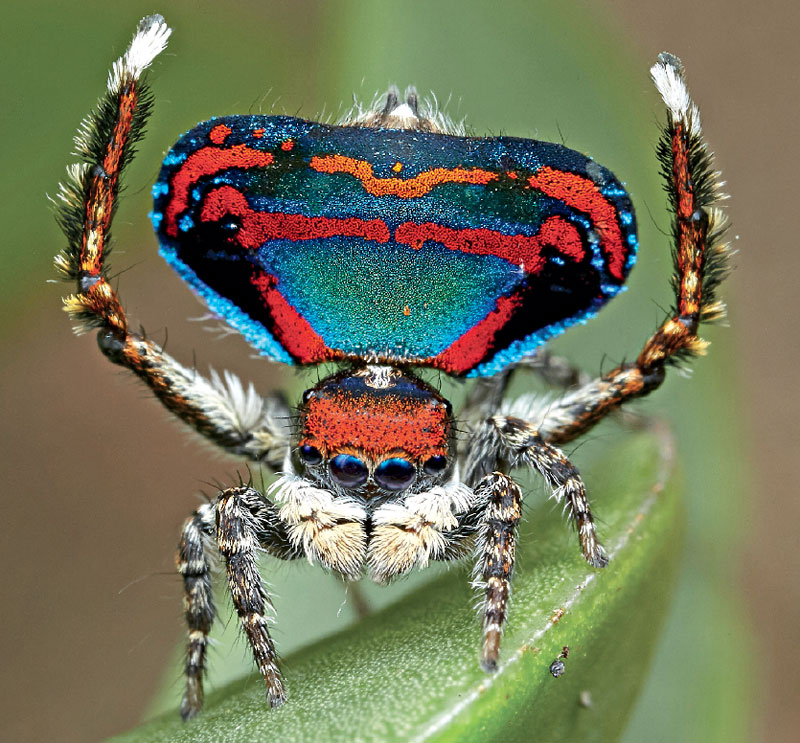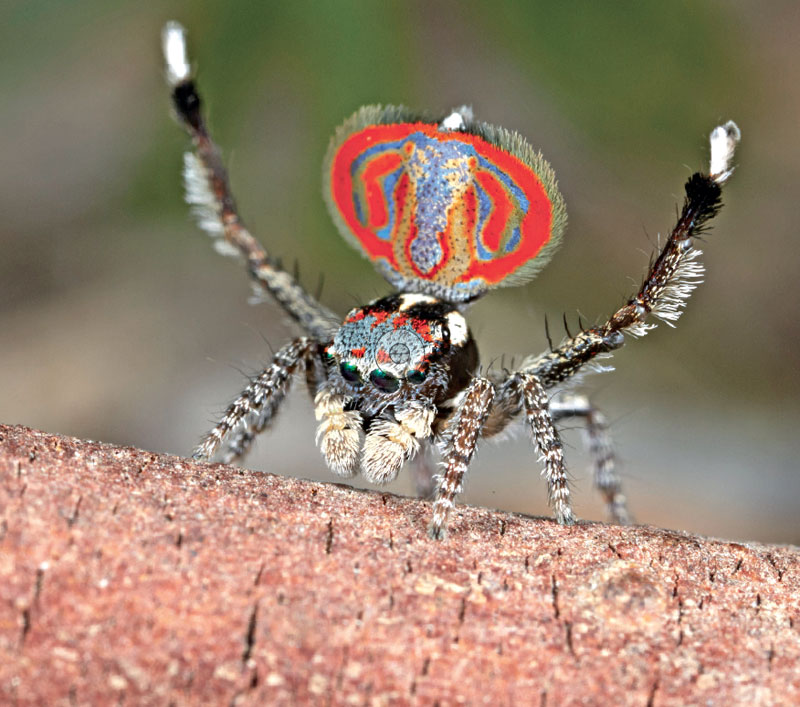
Sydney scientist Dr Jürgen Otto has some unusual problems. Holiday planning, for example, can be fraught with drama – not because of the need to find boarding houses for his family’s pet cats or dogs (they don’t have any) but because he keeps hundreds of live peacock spiders.
“Once when I went on holiday I had to give my collection to somebody at the Australian Museum,” he says of the unique arachnid entourage he keeps at his home in the northern Sydney suburb of St Ives.
Earlier this year he had over 250 little containers, each of which housed a peacock spider – small jumping spiders endemic to Australia. He says of his charges – genus Maratus, family Salticidae, measuring 2-6mm in length – that simply feeding them once a week (by opening each container and popping tiny live crickets in before snapping the lid shut) could take the better part of a day.
“That holiday I put them all in a suitcase and then went on the train and handed them over to the museum where they were looked after for a couple of weeks,” he recalls. “I try not to go away for longer periods because of that.”
When asked what it is that makes the peacock spider so special, the 50-year-old bubbles with enthusiasm.
“These big front eyes and the way they use them,” he begins. “They see the world in a similar way that we do and they react in a similar way … You can see them getting excited, frightened, they seem to display emotions.
“Then there’s the colouration,” he continues with dizzying enthusiasm about their iridescent hair and scales. The fact that they are so small, that such complexity in behaviour and beauty exists on such a tiny scale …
“If they were 10cm big, you might think that makes sense , but something that is that small and looks cute …” The scientist breaks off with a laugh.
Otto accidentally discovered his first peacock spider in September 2005 while walking through Ku-ring-gai Chase National Park with his wife, their two children and some friends.
The German-born biologist, who specialises in mites, was automatically scanning the ground. “That’s one of my habits,” he explains, when he spotted something unusual. “A little jumper, less than half a centimetre long … It seemed peculiar. I snapped a picture and noticed its colouration.
“I have very good eyesight, I see things that often other people don’t see, and I wonder why they don’t see it,” says Otto, adding that he suspects his red-green colour-blindness makes him unusually able to see outlines when others might not.
“That day changed my life, that’s for sure.”

Otto’s story began in the German town of Hofgeismar, where he grew up fascinated by living things. As a child he had a microscope. “I would do things like put grass into a glass of water, let it rot, look at all the little organisms that grew up in there and then draw them,” he recalls.
He badgered his parents into letting him keep lizards and snakes. While catching food for them at a tree-lined creek near his home, Otto became fascinated by spiders, and resolved to become a spider expert when he grew up.
Unfortunately, at the University of Bremen (where Otto studied biology), no master’s degree project in arachnids was available. Instead, he opted to specialise in mites, close relatives of spiders that are as small as a tenth of a millimetre in length – and as he became entranced by their minuscule world, he realised that he was very good at identifying tiny species.
Having fallen in love with Australia on a holiday in the mid 1980s, Otto skewed his research to enable him to work here, first by studying never-named imported mites, then the taxonomy of whirligig mites living in the country’s arid zones.
He met his wife, scientist Kate Wilson, moved to Townsville when she was offered a job at the Australian Institute of Marine Science, and began studying the marine mites of the Great Barrier Reef.
“When I started there was only a single marine mite known from the whole of Queensland … once I’d finished I had a collection of over 200, and pretty much every one I found was new,” he says, explaining that this was simply because nobody had been looking.
All Otto had to do to find new species was go to a beach and scoop up a handful of sand: “There’s so much coastline, so much ocean … it was this complete new area.”
A bigger challenge was finding names for them all. “Some of them are named after my family,” he laughs. “My wife has two named after her, my oldest son has one named after him [and] recently I named another new one after my younger son.”
Otto’s research funding ran out, and between science jobs he bought a digital SLR camera and took up photography with characteristic enthusiasm: “I had lots of fun, I did this day and night, photographing frogs, insects, lots of birds – I was always looking for new things to photograph.”
In 2005, the family moved to Sydney and Otto began working as a mite expert with the Australian Quarantine and Inspection Service.
“But I kept my interest in wildlife photography. I was desperate to find things to photograph here … but once I’d finished with the sulphur crested cockatoos and the lorikeets, there wasn’t much to do.” Otto laughs. “So I started to photograph flowers.”
He was looking for flowers on the day he found that first peacock spider. The tiny arachnid turned out to be Maratus volans. It was first documented in 1874 by an English clergyman and zoologist, the Reverend Octavius Pickard-Cambridge, who had been sent a specimen.
Volans is from the Latin for flying, the theory being that the spider could unfold flaps from its back and use them to glide. Intrigued, and learning of another theory that the male spiders used those colourful flaps for a courtship display which no human had ever witnessed, Otto decided to investigate.
“I thought maybe if I put a female with a male it might show such a display – but at the time the female was not known to science so I had no idea what it looked like,” he says. “It took me three years to find another spider.”

He scoured the bushland near his first spider discovery, eventually locating a drab individual that he thought might be a female and finding a male to put it with. A dramatic dancing courtship display took place before his eyes.
“It was very exciting. Nobody had seen it before, nobody had photographed it, it was completely new, like discovering birds of paradise in a way,” he says. “My first photographs of the display were quite sensational.”
It spurred him on to improve his photographs. “I took them at first on the dining room table. I had a pile of leaf litter that I dropped the spiders into, and photographed them there, and every time it was dinner time I had to clear the pile of leaves away.”
He discovered another species that had not been documented for over 100 years, witnessed a different arm-waving dance display (every peacock spider dance is different), realised that his SLR camera had a movie function and decided to film it.
In 2011 he posted his first peacock spider video on YouTube. “No-one had seen anything like it before,” he laughs. “People got excited. That first one has 1.8 million views to it now … It’s not much compared to my other ones but for me it was a ground-breaking experience.”
Another breakthrough came when he decided to add music to the peacock spider dances. “I only started doing that because I filmed them at home with children making noises in the background and I needed to do something to replace the sound,” Otto says.
Since then he has posted dozens of videos on his YouTube channel using the name “peacockspiderman” and watched, with some concern, as rogue videos have appeared in which his peacock spiders shake maracas, fight with light sabres, and dance to the “YMCA” song.
Otto has published 20 scientific papers in Peckhamia, a jumping spiders journal launched by US scientist and businessman David Hill, his scientific partner. Thirty-eight named species of peacock spiders are now described, including two nicknamed Sparklemuffin and Skeletorus, which made headlines worldwide.
Otto still has his day job and considers it ironic that for all his work on mites, it is his hobby for which he will be remembered. He is convinced that peacock spiders will become as iconic to Australia as koalas, kangaroos and kookaburras, is pleased by the interest in the tiny dancers and dreams of a time where arachnophobia is no more.
“People used to hate spiders, and some of them still do – but the vast majority fall in love with these creatures,” he says. “I show people a different side of the spider world.”







